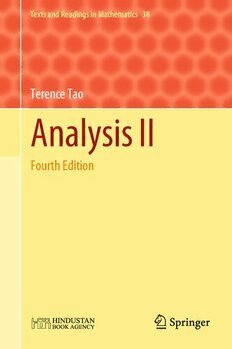Table Of ContentTexts and Readings in Mathematics 38
Terence Tao
Analysis II
Fourth Edition
Texts and Readings in Mathematics
AdvisoryEditor
C.S.Seshadri,ChennaiMathematicalInstitute,Chennai,India
ManagingEditor
RajendraBhatia,AshokaUniversity,Sonepat,India
EditorialBoard
ManindraAgrawal,IndianInstituteofTechnology,Kanpur,India
V.Balaji,ChennaiMathematicalInstitute,Chennai,India
R.B.Bapat,IndianStatisticalInstitute,NewDelhi,India
V.S.Borkar,IndianInstituteofTechnology,Mumbai,India
ApoorvaKhare,IndianInstituteofScience,Bangalore,India
T.R.Ramadas,ChennaiMathematicalInstitute,Chennai,India
V.Srinivas,TataInstituteofFundamentalResearch,Mumbai,India
TechnicalEditor
P.Vanchinathan,VelloreInstituteofTechnology,Chennai,India
TheTextsandReadingsinMathematicsseriespublisheshigh-qualitytextbooks,
research-level monographs, lecture notes and contributed volumes. Undergraduate
and graduate students of mathematics, research scholars and teachers would find
thisbookseriesuseful.Thevolumesarecarefullywrittenasteachingaidsandhigh-
lightcharacteristicfeaturesofthetheory.Booksinthisseriesareco-publishedwith
HindustanBookAgency,NewDelhi,India.
Terence Tao
Analysis II
Fourth Edition
TerenceTao
DepartmentofMathematics
UniversityofCaliforniaLosAngeles
LosAngeles,CA,USA
ISSN 2366-8717 ISSN 2366-8725 (electronic)
TextsandReadingsinMathematics
ISBN ISBN 978-981-19-7284-3 (eBook)
https://doi.org/10.1007/978-981-19-7284-3
JointlypublishedwithHindustanBookAgency
Thisworkisaco-publicationwithHindustanBookAgency,NewDelhi,licensedforsaleinallcountries
inelectronicformonly.SoldanddistributedinprintacrosstheworldbyHindustanBookAgency,P-19
GreenParkExtension,NewDelhi110016,India.
ISBN:978-81-951961-2-8©HindustanBookAgency2022
Springerhasonlyelectronicright
3rdedition:©SpringerScience+BusinessMediaSingapore2016andHindustanBookAgency2015
4thedition:©HindustanBookAgency2022
Thisworkissubjecttocopyright.AllrightsaresolelyandexclusivelylicensedbythePublisher,whether
thewholeorpartofthematerialisconcerned,specificallytherightsoftranslation,reprinting,reuse
ofillustrations,recitation,broadcasting,reproductiononmicrofilmsorinanyotherphysicalway,and
transmissionorinformationstorageandretrieval,electronicadaptation,computersoftware,orbysimilar
ordissimilarmethodologynowknownorhereafterdeveloped.
Theuseofgeneraldescriptivenames,registerednames,trademarks,servicemarks,etc.inthispublication
doesnotimply,evenintheabsenceofaspecificstatement,thatsuchnamesareexemptfromtherelevant
protectivelawsandregulationsandthereforefreeforgeneraluse.
Thepublishers,theauthors,andtheeditorsaresafetoassumethattheadviceandinformationinthisbook
arebelievedtobetrueandaccurateatthedateofpublication.Neitherthepublishersnortheauthorsor
theeditorsgiveawarranty,expressedorimplied,withrespecttothematerialcontainedhereinorforany
errorsoromissionsthatmayhavebeenmade.Thepublishersremainneutralwithregardtojurisdictional
claimsinpublishedmapsandinstitutionalaffiliations.
ThisSpringerimprintispublishedbytheregisteredcompanySpringerNatureSingaporePteLtd.
The registered company address is: 152 Beach Road, #21-01/04 Gateway East, Singapore 189721,
Singapore
Tomyparents,foreverything
Preface to the First Edition
ThistextoriginatedfromthelecturenotesIgaveteachingthehonoursundergraduate-
level real analysis sequence at the University of California, Los Angeles, in 2003.
Amongtheundergraduateshere,realanalysiswasviewedasbeingoneofthemost
difficultcoursestolearn,notonlybecauseoftheabstractconceptsbeingintroduced
forthefirsttime(e.g.,topology,limits,measurability,etc.),butalsobecauseofthe
level of rigour and proof demanded of the course. Because of this perception of
difficulty,onewasoftenfacedwiththedifficultchoiceofeitherreducingthelevel
ofrigourinthecourseinordertomakeiteasier,ortomaintainstrictstandardsand
facetheprospectofmanyundergraduates,evenmanyofthebrightandenthusiastic
ones,strugglingwiththecoursematerial.
Faced with this dilemma, I tried a somewhat unusual approach to the subject.
Typically, an introductory sequence in real analysis assumes that the students are
alreadyfamiliarwiththerealnumbers,withmathematicalinduction,withelementary
calculus,andwiththebasicsofsettheory,andthenquicklylaunchesintotheheart
of the subject, for instance the concept of a limit. Normally, students entering this
sequencedoindeedhaveafairbitofexposuretotheseprerequisitetopics,though
inmostcasesthematerialisnotcovered inathoroughmanner.Forinstance,very
fewstudentswereabletoactuallydefinearealnumber,orevenaninteger,properly,
even though they could visualize these numbers intuitively and manipulate them
algebraically. This seemed to me to be a missed opportunity. Real analysis is one
ofthefirstsubjects(togetherwithlinearalgebraandabstractalgebra)thatastudent
encounters,inwhichonetrulyhastograpplewiththesubtletiesofatrulyrigorous
mathematicalproof.Assuch,thecourseofferedanexcellentchancetogobackto
thefoundationsofmathematics,andinparticulartheopportunitytodoaproperand
thoroughconstructionoftherealnumbers.
Thus the course was structured as follows. In the first week, I described some
well-known “paradoxes” in analysis, in which standard laws of the subject (e.g.,
interchangeoflimitsandsums,orsumsandintegrals)wereappliedinanon-rigorous
waytogivenonsensicalresultssuchas0=1.Thismotivatedtheneedtogobackto
theverybeginningofthesubject,eventotheverydefinitionofthenaturalnumbers,
andcheckallthefoundationsfromscratch.Forinstance,oneofthefirsthomework
vii
viii PrefacetotheFirstEdition
assignmentswastocheck(usingonlythePeanoaxioms)thatadditionwasassociative
for natural numbers (i.e., that (a+b)+c = a +(b+c) for all natural numbers
a, b, c: see Exercise 2.2.1). Thus even in the first week, the students had to write
rigorous proofs using mathematical induction. After we had derived all the basic
propertiesofthenaturalnumbers,wethenmovedontotheintegers(initiallydefined
asformaldifferencesofnaturalnumbers);oncethestudentshadverifiedallthebasic
propertiesoftheintegers,wemovedontotherationals(initiallydefinedasformal
quotientsofintegers);andthenfromtherewemovedon(viaformallimitsofCauchy
sequences)tothereals.Aroundthesametime,wecoveredthebasicsofsettheory,
forinstancedemonstratingtheuncountabilityofthereals.Onlythen(afteraboutten
lectures)didwebeginwhatonenormallyconsiderstheheartofundergraduatereal
analysis—limits,continuity,differentiability,andsoforth.
The response to this format was quite interesting. In the first few weeks, the
students found the material very easy on a conceptual level, as we were dealing
onlywiththebasicpropertiesofthestandardnumbersystems.Butonanintellectual
level it was very challenging, as one was analyzing these number systems from a
foundationalviewpoint,inordertorigorouslyderivethemoreadvancedfactsabout
thesenumbersystemsfromthemoreprimitiveones.Onestudenttoldmehowdiffi-
cult it was to explain to his friends in the non-honours real analysis sequence (a)
why he was still learning how to show why all rational numbers are either posi-
tive,negative,orzero(Exercise4.2.4),whilethenon-honourssequencewasalready
distinguishingabsolutelyconvergentandconvergentseries,and(b)why,despitethis,
hethoughthishomeworkwassignificantlyharderthanthatofhisfriends.Another
studentcommentedtome,quitewryly,thatwhileshecouldobviouslyseewhyone
couldalwaysdivideanaturalnumbern intoapositiveintegerq togiveaquotient
a and a remainder r less than q (Exercise 2.3.5), she still had, to her frustration,
much difficulty in writing down a proof of this fact. (I told her that later in the
course she would have to prove statements for which it would not be as obvious
to see that the statements were true; she did not seem to be particularly consoled
bythis.)Nevertheless,thesestudentsgreatlyenjoyedthehomework,aswhenthey
didperservereandobtainarigorousproofofanintuitivefact,itsolidifiedthelink
intheirmindsbetweentheabstractmanipulationsofformalmathematicsandtheir
informalintuitionofmathematics(andoftherealworld),ofteninaverysatisfying
way. By the time they were assigned the task of giving the infamous “epsilon and
delta”proofsinrealanalysis,theyhadalreadyhadsomuchexperiencewithformal-
izing intuition, and in discerning the subtleties of mathematical logic (such as the
distinction between the “for all” quantifier and the “there exists” quantifier), that
thetransitiontotheseproofswasfairlysmooth,andwewereabletocovermaterial
both thoroughly and rapidly. By the tenth week, we had caught up with the non-
honoursclass,andthestudentswereverifyingthechangeofvariablesformulafor
Riemann–Stieltjesintegrals,andshowingthatpiecewisecontinuousfunctionswere
Riemann integrable. By the conclusion of the sequence in the twentieth week, we
had covered (both in lecture and in homework) the convergence theory of Taylor
PrefacetotheFirstEdition ix
andFourierseries,theinverseandimplicitfunctiontheoremforcontinuouslydiffer-
entiablefunctionsofseveralvariables,andestablishedthedominatedconvergence
theoremfortheLebesgueintegral.
Inordertocoverthismuchmaterial,manyofthekeyfoundationalresultswere
lefttothestudenttoproveashomework;indeed,thiswasanessentialaspectofthe
course,asitensuredthestudentstrulyappreciatedtheconceptsastheywerebeing
introduced.Thisformathasbeenretainedinthistext;themajorityoftheexercises
consist of proving lemmas, propositions and theorems in the main text. Indeed, I
wouldstronglyrecommendthatonedoasmanyoftheseexercisesaspossible—and
thisincludesthoseexercisesproving“obvious”statements—ifonewishestousethis
texttolearnrealanalysis;thisisnotasubjectwhosesubtletiesareeasilyappreciated
justfrompassivereading.Mostofthechaptersectionshaveanumberofexercises,
whicharelistedattheendofthesection.
To the expert mathematician, the pace of this book may seem somewhat slow,
especiallyinearlychapters,asthereisaheavyemphasisonrigour(exceptforthose
discussionsexplicitlymarked“Informal”),andjustifyingmanystepsthatwouldordi-
narilybequicklypassedoverasbeingself-evident.Thefirstfewchaptersdevelop(in
painfuldetail)manyofthe“obvious”propertiesofthestandardnumbersystems,for
instancethatthesumoftwopositiverealnumbersisagainpositive(Exercise5.4.1),
orthatgiven anytwodistinctrealnumbers,onecanfindrationalnumber between
them(Exercise5.4.5).Inthesefoundationalchapters,thereisalsoanemphasison
non-circularity—notusinglater,moreadvancedresultstoproveearlier,moreprim-
itiveones.Inparticular,theusuallawsofalgebraarenotuseduntiltheyarederived
(andtheyhavetobederivedseparatelyforthenaturalnumbers,integers,rationals,
andreals).Thereasonforthisisthatitallowsthestudentstolearntheartofabstract
reasoning,deducingtruefactsfromalimitedsetofassumptions,inthefriendlyand
intuitivesettingofnumbersystems;thepayoffforthispracticecomeslater,whenone
hastoutilizethesametypeofreasoningtechniquestograpplewithmoreadvanced
concepts(e.g.,theLebesgueintegral).
Thetexthereevolvedfrommylecturenotesonthesubject,andthusisverymuch
orientedtowardsapedagogical perspective;muchofthekeymaterialiscontained
insideexercises,andinmanycasesIhavechosentogivealengthyandtedious,but
instructive,proofinsteadofaslickabstractproof.Inmoreadvancedtextbooks,the
studentwillseeshorterandmoreconceptuallycoherenttreatmentsofthismaterial,
andwithmoreemphasisonintuitionthanonrigour;however,Ifeelitisimportantto
knowhowtodoanalysisrigorouslyand“byhand”first,inordertotrulyappreciate
the more modern, intuitive and abstract approach to analysis that one uses at the
graduatelevelandbeyond.
Theexpositioninthisbookheavilyemphasizesrigourandformalism;however
thisdoesnotnecessarilymeanthatlecturesbasedonthisbookhavetoproceedthe
same way. Indeed, in my own teaching I have used the lecture time to present the
intuitionbehindtheconcepts(drawingmanyinformalpicturesandgivingexamples),
thus providing a complementary viewpoint to the formal presentation in the text.
The exercises assigned ashomework provide anessentialbridge between thetwo,
requiring the student to combine both intuition and formal understanding together
x PrefacetotheFirstEdition
inordertolocatecorrectproofsforaproblem.ThisIfoundtobethemostdifficult
task for the students, as it requires the subject to be genuinely learnt, rather than
merelymemorizedorvaguelyabsorbed.Nevertheless,thefeedbackIreceivedfrom
thestudentswasthatthehomework,whileverydemandingforthisreason,wasalso
very rewarding, as it allowed them to connect the rather abstract manipulations of
formalmathematicswiththeirinnateintuitiononsuchbasicconceptsasnumbers,
sets,andfunctions.Ofcourse,theaidofagoodteachingassistantisinvaluablein
achievingthisconnection.
Withregardtoexaminationsforacoursebasedonthistext,Iwouldrecommend
eitheranopen-book,open-notesexaminationwithproblemssimilartotheexercises
given in the text (but perhaps shorter, with no unusual trickery involved), or else
a take-home examination that involves problems comparable to the more intricate
exercisesinthetext.Thesubjectmatteristoovasttoforcethestudentstomemorize
thedefinitionsandtheorems,soIwouldnotrecommendaclosed-bookexamination,
oranexaminationbasedonregurgitatingextractsfromthebook.(Indeed,inmyown
examinations I gave a supplemental sheet listing the key definitions and theorems
whichwererelevanttotheexaminationproblems.)Makingtheexaminationssimilar
tothehomeworkassignedinthecoursewillalsohelpmotivatethestudentstowork
through and understand their homework problems as thoroughly as possible (as
opposedto,say,usingflashcardsorothersuchdevicestomemorizematerial),which
isgoodpreparationnotonlyforexaminationsbutfordoingmathematicsingeneral.
Someofthematerialinthistextbookissomewhatperipheraltothemaintheme
and may be omitted for reasons of time constraints. For instance, as set theory is
notasfundamentaltoanalysisasarethenumbersystems,thechaptersonsettheory
(Chapters3,8)canbecoveredmorequicklyandwithsubstantiallylessrigour,orbe
givenasreadingassignments.Theappendicesonlogicandthedecimalsystemare
intendedasoptionalorsupplementalreadingandwouldprobablynotbecoveredin
the main course lectures; the appendix on logic is particularly suitable for reading
concurrently with the first few chapters. Also, Chapter 5 (on Fourier series) is not
neededelsewhereinthetextandcanbeomitted.
For reasons of length, this textbook has been split into two volumes. The first
volumeisslightlylonger,butcanbecoveredinaboutthirtylecturesiftheperipheral
materialisomittedorabridged.Thesecondvolumerefersattimestothefirst,butcan
alsobetaughttostudentswhohavehadafirstcourseinanalysisfromothersources.
Italsotakesaboutthirtylecturestocover.
Iamdeeplyindebtedtomystudents,whoovertheprogressionoftherealanal-
ysis course corrected several errors in the lectures notes from which this text is
derived, and gave other valuable feedback. I am also very grateful to the many
anonymous referees who made several corrections and suggested many impor-
tant improvements to the text. I also thank Adam, James Ameril, Quentin Batista,
Biswaranjan Behara, José Antonio Lara Benítez, Dingjun Bian, Petrus Bianchi,
Phillip Blagoveschensky, Tai-Danae Bradley, Brian, Eduardo Buscicchio, Carlos,
cebismellim,MatheusSilvaCosta,GonzalesCastilloCristhian,Ck,WilliamDeng,
Kevin Doran, Lorenzo Dragani, EO, Florian, Gyao Gamm, Evangelos Georgiadis,
AdityaGhosh,ElieGoudout,TiGong,UlrichGroh,GökhanGüçlü,YaverGulusoy,

